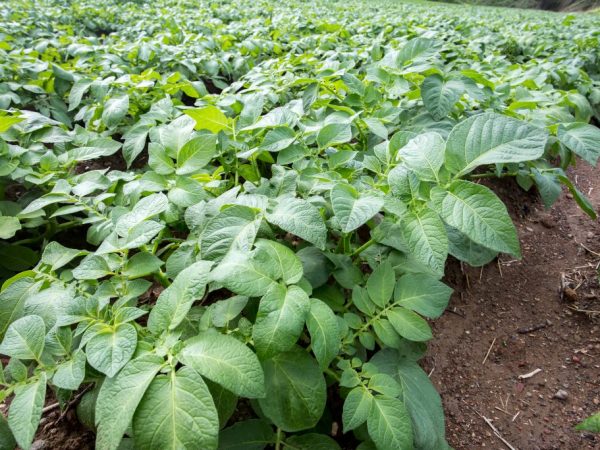Why potatoes don't bloom
Potatoes grow in almost every vegetable garden. Growing this crop is not a difficult process, but novice farmers have a lot of questions. For example, when do potatoes bloom and why? Should you panic and what to do if the potatoes are not blooming?

Lack of flowering in potatoes
Why potatoes bloom
About a month after planting the seeds in the soil, the potato fruits are already blooming. This can happen earlier if pre-germination has taken place.
The thing is that stolons begin to grow underground, tubers are formed, and flowers bloom on the surface at this time. Some of them subsequently form a fruit or berry with seeds, some shed flowers.
Should I interfere with flowering
It is undesirable to hinder the natural development of the plant. Plucking flowers means injuring the stems, which at this moment may be in the sleep stage. To recover, they will have to spend a lot of energy that could go to the formation of tubers. It is unknown how long rehabilitation will take.
Purely mechanical damage is inevitable during the removal of flowers. The gardener will probably remember the stems while he picks the flowers. If at least one of the bushes has a small wound, infection is possible. There is no reason to expose your garden to additional danger.
No need to disturb the plants when they bloom.
The lack of flowering is a signal of an error in care or an attack by pests. If this happens, the plants are fed for several days with wood ash or chicken droppings, because budding indicates the onset of tuberization. The plant should receive a sufficient amount of moisture: the soil should be moistened to a depth of 6 cm. On average, the bush should receive 3 liters of water at a time. Also, the plant needs sunlight for good development.
Flowering and non-flowering varieties
People who are confused by the budding process may choose varieties of non-flowering potatoes. The varieties Timo and the Empress do not have a similar trait at all: they are not genetically predisposed to flowering. This group also includes the early Mariella and Rocco, which ripen so early that they do not have time to open the buds.
Flowering potato varieties include Alvara, Nevsky, Golubizna, Gatchinsky, Nikulinsky, Druzhny, Istrinsky, Rosamunda, Erbitsky, Kamensky. Some of them bloom so beautiful bright flowers (blue, scarlet, purple) that the owners specially select such a variety to decorate the garden. These are the old types of potatoes that are most common in our country.
Separately, it is worth highlighting the potatoes Courier, Vyatka, Early Rosa, Table 19: their flowering is influenced by the weather, care and other factors.
Natural reasons for the lack of flowering
Breeders have bred varieties (usually early potatoes) that do not grow flowers.Tubers grow earlier and such potatoes are less susceptible to infection by fungal diseases and attacks of parasites: all its power is aimed at maintaining immunity.
Sometimes the farmer may not notice that the potatoes are blooming if the phenomenon was short-lived and did not last too long. In addition, the flowers are small in size and therefore overlooked.
Some varieties, if they lack moisture, decide not to waste extra energy. This is another weather explanation for why potatoes don't bloom.
If the stems of a plant begin to wilt, it suffers from heat.
Other reasons

Potato bloom depends on many factors.
Other reasons for the lack of flowering on potatoes are:
- attack by pests such as ladybugs or ground beetles;
- planting fruits in the shade;
- the choice of not too fertile soil for planting.
- overfeeding with nitrogen fertilizers.
- excessive watering.
Basically, the reasons listed are related to the farmer's mistakes. How global they turned out to be can be found out when the time comes to dig a garden.
Leaving during flowering
Budding is accompanied by active tuberous growth of potato fruits. This process should be supported by top dressing. The first is introduced at the beginning of budding in order to accelerate it. 3 tbsp. l ash is mixed with 1 tsp. potassium sulfate per 1 m of the garden. The next top dressing (2 tablespoons superphosphate) is carried out on the 5th day of flowering.
The method is rooted. You can also try foliar feeding. For a hundred square meters per 10 liters of water, take 50 g of potassium sulfate, 40 g of urea, 20 g of ammonium nitrate.
Protection from Colorado beetles during flowering is not easy. It is impossible to resort to the help of chemicals. There are 2 ways out: to destroy the parasites by hand, or to use folk remedies.
An easy way is to sprinkle cornmeal on the bushes. You can also prepare a special product by boiling 10 liters of water with wood ash added there in a volume of 1 kg and 50 g of crushed laundry soap. Both remedies are recommended to be used no more than once a week. In a mass attack, a biological drug such as Fitoverma is used.
Conclusion
The phenomenon of non-flowering potatoes (as well as flowering ones) does not threaten the harvest.
To check the level of danger, the main thing is to find out why the potatoes are not blooming. If the reasons are not related to poorly organized care or an unfavorable external environment, there is no reason for concern: the lack of budding will not affect the crop. There is also no need to tear off the formed buds.


